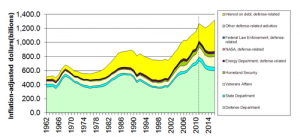Iraq and Afghanistan War Expenditures
 President Bush’s Global War on Terrorism has especially come at a high price to the United States, and the total amounts are staggering to say the least. The phrase was coined by Bush on September 20, 2001, when the nation culminated to a very vulnerable point, right after the 9/11 crisis erupted. The post 9/11 wars have become the most expensive in US history, bar none. The total cost is estimated to be from $4 to $6 trillion for the Iraq and Afghanistan war expenditures.
President Bush’s Global War on Terrorism has especially come at a high price to the United States, and the total amounts are staggering to say the least. The phrase was coined by Bush on September 20, 2001, when the nation culminated to a very vulnerable point, right after the 9/11 crisis erupted. The post 9/11 wars have become the most expensive in US history, bar none. The total cost is estimated to be from $4 to $6 trillion for the Iraq and Afghanistan war expenditures.
“The Iraq and Afghanistan conflicts, taken together, will be the most expensive wars in US history – totaling somewhere between $4 to $6 trillion,” according to a new research paper (March 2013) by Linda Bilmes. The paper is titled The Financial Legacy of Iraq and Afghanistan: How Wartime Spending Decisions Will Constrain Future National Security Budgets.
Global War on Terror Costs
“A March 2011 Congressional report estimated spending related to the war through fiscal year 2011 at $1.2 trillion, and that spending through 2021 assuming a reduction to 45,000 troops would be $1.8 trillion. A June 2011 academic report covering additional areas of spending related to the war estimated it through 2011 at $2.7 trillion, and long term spending at $5.4 trillion including interest” per Wikipedia, War on Terror — Costs.
Colossal Military Budget of the United States
The dedicated military budget of the United States does not include: “many military-related items that are outside of the Defense Department budget, such as nuclear weapons research, maintenance, cleanup, and production, which is in the Department of Energy budget, Veterans Affairs, the Treasury Department’s payments in pensions to military retirees and widows and their families, interest on debt incurred in past wars, or State Department financing of foreign arms sales and militarily-related development assistance.”
“The Military budget of the United States for the 2009 fiscal year was $515.4 billion. Adding emergency discretionary spending and supplemental spending brings the sum to $651.2 billion.”
Military–Industrial Complex Theory
A thesis originally expressed by Daniel Guérin, in his 1936 book Fascism and Big Business, about the fascist government support to heavy industry:
The Military–Industrial Complex can be defined as, “an informal and changing coalition of groups with vested psychological, moral, and material interests in the continuous development and maintenance of high levels of weaponry, in preservation of colonial markets and in military-strategic conceptions of internal affairs.”
Defense Lobbying Contributions
Defense lobbying statistics are provided by Center for Responsive Politics. The defense sector is one of the most powerful in politics and it includes: defense aerospace, defense electronics and other miscellaneous defense companies. Just click on the link to find out who the top players are and the enormous amounts of capital they are spending.
Related News
From Russia Today: Obama breaks nuclear pledge, invests $10 billion in weapons.

